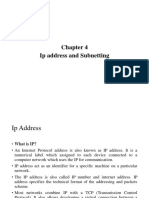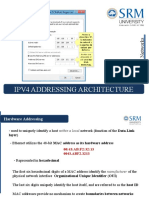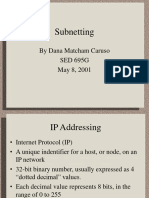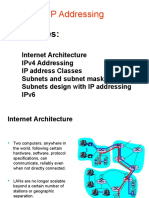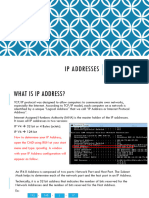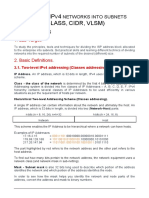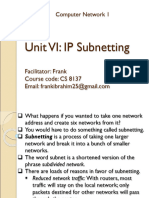0 ratings 0% found this document useful (0 votes) 8 views 15 pages IP Addressing Guide
The document is a comprehensive guide on IP addressing and subnetting, covering topics such as IP address fundamentals, binary mathematics, subnet masks, CIDR notation, and IPv6. It explains the importance of subnetting for network organization, security, and efficient IP usage, along with practical examples and calculations for subnetting. Additionally, it includes sections on Network Address Translation (NAT) and practice problems with solutions to reinforce learning.
AI-enhanced title and description
Copyright
© © All Rights Reserved
We take content rights seriously. If you suspect this is your content,
claim it here .
Available Formats
Download as PDF or read online on Scribd
Go to previous items Go to next items
Save IP addressing guide For Later Complete IP Addressing & Subnetting Guide
A self-explanatory guide to master networking fundamentals
Table of Contents
1. IP Address Fundamentals
2. Binary Mathematics
3. IP Address Classes
4, Subnet Masks Explained
5. Subnetting Step-by-Step
6. CIDR Notation
7. Advanced Subnetting
8. IPV6 Fundamentals
9, Network Address Translation (NAT),
10. Practice Problems with Solutions
1. IP Address Fundamentals
What is an IP Address?
An IP (Internet Protocol) address is a unique identifier for devices on a network. Think of it ike a postal
address for your computer.
IPv4 Structure:
* 32 bits total (4 bytes)
* Written as 4 octets separated by dots
* Each octet ranges from 0-255
«Example: (192.168.1.100)
Why Do We Need Subnetting?
Imagine you have a large office building, Instead of giving every room the same address, you divide it
into floors and room numbers. Subnetting does the same thing for networks - it creates smaller,
manageable network segments.
Benefits:�* Reduces broadcast traffic (less network congestion)
* Improves security (isolates network segments)
* Better organization (logical grouping of devices)
* Efficient IP usage (no wasted addresses)
2. Binary Mathematics
Understanding Binary
Computers think in binary (0s and 1). To master subnetting, you need to understand binary.
Dee
all vs Binary:
Decimal: 192
Binary: 11000000
How to convert
Position: 128 64 32 16 8 4.21
Binay: 11000000
Values: 128 + 64 = 192
Binary Conversion Methods
Method 1: Place Value Addition
Example: Convert 11010110 to decimal
Position: 128 64 32 16 8 4 2 1
Binay: 11010110
Values: 128+ 64+0+ 16+0+4+2+0=214
Method 2: Subtraction Method�Example: Convert 214 to binary
214-128 = 86 — Bit7=1
86-64=22 + Bite=
22<32 © =BitS=0
22-16=6 —Bit4=1
6<8 — ~Bit3
6-4-2 +Bit2=1
2-2-0 ~Bitt=1
o<1 — +Bito=0
Result: 11010110
Quick Reference Table
Decimal Binary Decimal Binary
0 0000000 128 10000000
1 00000001 192 11000000
3 (00000011 224 11100000
7 00000111 240 11110000
15 00001111 248 11111000
3 00011111 252 11111100
68 00111111 234 11111110
127 ona 255 wait
3. IP Address Classes
Class A Networks
Range: 1.0.0.0 to 126.255.255.255 Default Mask: 255.0.0.0 (/8) Structure: N.H.H.H (N=Network, H=Host)
Example: 10.50.100.25
Network portion: 10
Host portion: 50.100.25
Hosts per network: 2424 - 2 = 16,777,214
Key Points:
* 127.x.xx is reserved for loopback
* 10.x.x.x is private (RFC 1918)
© Used for very large networks�Class B Networks
Range: 128.0.0.0 to 191.255.255.255 Default Mask: 255.255.0.0 (/16) Structure: N.N.HH
Example: 172.16.50.100
Network portion: 172.16
Host portion: 50.100
Hosts per network: 2916 - 2 = 65,534
Key Point
© 172.16.0.0 - 172.31.255.255 is private
‘* Used for medium-sized networks
Class C Networks
Range: 192.0.0.0 to 223.255.255.255 Default Mask: 255.255.255.0 (/24) Structure: N.N.N.H
Example: 192.168.1.100
Network portion: 192.168.1
Host portion: 100
Hosts per network: 298 - 2 = 254
Key Points:
© 192.168.x.x is private
* Used for small networks
Special Address Ranges
© Class D (224-239): Multicast
* Class E (240-255): Experimental
© 169.254.x.x APIPA (Automatic Private IP)
© 127.x.xx: Loopback
4, Subnet Masks Explained
What is a Subnet Mask?
A subnet mask tells the computer which part of an IP address is the network and which part is the host.
Think of it like this:�IP Address: 192.168.1.100
Subnet Mask: 255.255.255.0
The mask says: "The first 3 octets (192.168.1) identify the network,
and the last octet (100) identifies the host.”
How Subnet Masks Work
Subnet masks use a logical AND operation:
IP Address: 192.168.1.100 = 11000000.10101000.00000001.01100100
Subnet Mask: 255.255.255.0 = 19111111.11111111.11111111.00000000
t '
Network bits Host bits
Result (Network): 192.168.1.0 = 11000000.10107000.00000001.00000000
Common Subnet Masks
IDR _| Decimal Mask ary (last octet) Hosts _| Subnets (from /24)
[4 255.255.2550 00000000 254 1
RS 255.255.255.128 ‘10000000 126 2
[26 255.255.255.192 11000000 62 4
‘(27 255.255.255.224 11100000 30 8
[28 255.255.255.240 11110000 14 16
Lg 255.255.255.248 11111000 6 32
730 255.255.255.252 41111100 2 6a
5. Subnetting Step-by-Step
The Magic Formula
24n borrowed bits)
24h - 2 = Number of hosts (where h
Block Size = 256 - subnet mask value
Number of subnets (where
remaining host bits)
Example 1: Basic Subnetting
Problem: Subnet 192.168.1.0/24 to create 4 subnets
Step 1: Determine bits needed�* Need 4 subnets
* 24n2 4,son = 2 bits needed
© Borrow 2 bits from host portion
Step 2: Calculate new mask
© Original: /24 (255.255.255.0)
© New: /24 + 2 = /26 (255.255.255.192)
Step 3: Calculate block size
© Block size = 256 - 192 = 64
* Each subnet has 64 addresses
Step 4: List the subnets
Subnet 1: 192.168.1.0/26 (Range: 0-63)
= Network: 192.168.1.0
First host: 192.168.1.1
~ Last host: 192.168.1.62
~ Broadcast: 192.168.1.63
Subnet 2: 192.168.1.64/26 (Range: 64-127)
- Network: 192.168.1.64
- First host: 192.168.1.65
= Last host: 192.168.1.126
- Broadcast: 192.168.1.127
Subnet 3: 192,168.1.128/26 (Range: 128-191)
Subnet 4: 192.168.1.192/26 (Range: 192-255)
Example 2: Variable Length Subnet Masking (VLSM)
Problem: You have 192.168.1.0/24 and need:
* Network A: 50 hosts
«Network B: 25 hosts
‘© Network C: 10 hosts
* Network D: 2 hosts (point-to-point)
Solution Strategy: Start with the largest requirement
Network A (50 hosts):
* Need 246 - 2 = 62 usable hosts�© Use /26: 192.168.1.0/26 (0-63)
Network B (25 hosts):
* Need 245 - 2 = 30 usable hosts
© Use /27: 192.168.1.64/27 (64-95)
Network C (10 hosts):
© Need 244 - 2 = 14 usable hosts
© Use /28: 192.168.1.96/28 (96-111)
Network D (2 hosts):
© Need 242 - 2 = 2 usable hosts
© Use /30: 192.168.1.112/30 (112-115)
Remaining space: 192.168.1.116/30 through 192.168.1.252/30
6. CIDR Notation
Understanding CIDR
CIDR (Classless Inter-Domain Routing) eliminates the rigid class system.
Format: Network/Prefix Length
© Example: 192.168.1.0/24
© The "/24" means 24 bits for network, 8 bits for hosts
CIDR Benefits
1. Flexible addressing - Not limited to /8, /16, /24
2, Route aggregation - Combine multiple routes
3. Efficient allocation - Use exactly what you need
Route Summarization Example
Individual routes:
~ 192,168.0,0/24
= 192.168.1.0/24
~ 192.168.2.0/24
-192.168.3.0/24
Can be summarized as:
~ 192.168.0.0/22 (covers all four networks)�Binary analysis
192.168.0x = 11000000.10101000,00000000 xo...
192.168.1.x = 11000000.10101000,00000001 ,o.0.000x%
192.168.2.x = 11000000.10101000,00000010.xxx0000xx
192.168.3.x = 11000000.10101000,0000001 1 xxxx000xx
roroat
Common bits = 22
7. Advanced Subnetting
Supernetting
Supernetting combines multiple networks into a larger one.
Example:
Combine: 172.16.0.0/16 and 172.17.0.0/16
Binary analysis:
172.16xx = 10101100,0001000030000000432000000K
172.17.xx = 10101100.00010007 90000%% 2000000
tort
Commen bits
Result: 172.16.0.0/15 (covers 172.16.0.0 through 172.17.255.255)
Wildcard Masks (for Cisco ACLs)
Formula: Wildcard = 255.255.255.255 - Subnet Mask
Examples:
Subnet Mask: 255.255.255.0 — Wildcard: 0.0.0.255
Subnet Mask: 255.255.255.192 ~+ Wildcard: 0.0.0.63
Subnet Mask: 255.255.2400 — Wildcard: 0.0.15.255
Calculating Hosts and Subnets
Given network: 10.0.0.0/8, create subnets with at least 1000 hosts each
Step 1: Determine host bits needed
24h -2 2 1000
2910 - 2 = 1022 hosts V
Need 10 host bits�Step 2: Calculate subnet bits
Total bits: 32
Network bits (original: 8
Host bits needed: 10
Subnet bits: 32 - 8 - 10 = 14
Step 3: Results
New mask: /8 + 14 = /22
Number of subnets: 2414 = 16,384
Hosts per subnet: 2410 - 2 = 1,022
8. IPv6 Fundamentals
IPv6 Address Structure
* 128 bits total (16 bytes)
‘* Written as 8 groups of 4 hexadecimal digits
© Groups separated by colons
+ ample
IPv6 Address Types
1. Global Unicast (2000::/3)
Example: 2001:db8:1234'5678:1
Purpose: Internet routable addresses
Scope: Global
2. Link-Local (fe80::/10)
Example: fe80:1
Purpose: Local network communication
Scope: Link only (not routed)
3. Multicast (ff00::/8)
{02:1 - All nodes on link
{102:2 - All routers on link
{02:5 - All OSPF routers
4, Unique Local (fc00::/7)�Example: fd12:3456:789a::1
Purpose: Private addressing (like RFC 1918)
Scope: Organization
IPv6 Compression Rules
Original: 2001 :04b8:0000:0000:0000:0000:0000:0001
Rule 1 - Remove leading zeros:
2001:4b8:0:00.0:0:1
Rule 2 - Compress consecutive zeros (: once only)
2001:db8:1
IPv6 Subnetting
Example: 2001:db8:1234:/48 network
Subnet Structure:
2001:clb8:1234:SSSSiINEIILIIIIL
tt
Subnet Interface ID
(16 bits) (64 bits)
Common subnets:
2001:db8:1234:0000:/64
2001:db8:1234:0001:/64
2001:db8:1234:0002:/64
2001:db8:1 234: /64
Total possible subnets: 216 = 65,536
9. Network Address Translation (NAT)
Why NAT?
1. IPv4 address conservation - Share public IPs
2. Security - Hide internal network structure
3. Flexil
ity - Change internal addressing without affecting external�NAT Types
1. Static NAT (1:1)
Internal: 192.168.1.100 + External: 203.0.113.10
Internal: 192.168.1,101 = External: 203.0.113.11
Characteristics:
~ Permanent mapping
- One-to-one relationship
- Used for servers
2. Dynamic NAT (Many:Many)
Internal Pool: 192.168.1.100-200
Extetnal Pool: 203.0.113.10-20
Process:
1. Internal host needs external access
2. Router assigns available public IP
3. Mapping removed when session ends
PAT/NAT Overload (Many:1)
Internal IPs + Single External IP using different ports
192.168.1.100:3000 + 203.0.113.10:20000
192.168.1.101:3001 — 203,0.113.10:20001
192.168.1.102:80 + 203.0.113.10:20002
Translation Table:
Inside Local | Inside Global
192.168.1.100:3000 | 203.0.113.10:20000
192.168.1.101:3001 | 203.0.113.10:20001
10. Practice Problems with Solutions
Problem 1: Basic Subnetting
Question: Subnet 172.16.0.0/16 to create 8 subnets. List the first 3 subnets with their ranges.
Solution:�Step 1: Bits needed for 8 subnets
20n28 +n =3bits
Step 2: New mask
ING + 3 = /19 (255.255.2240)
Step 3: Block size
256 - 224 = 32 (in 3rd octet)
Step 4: Subnets
Subnet 1: 172.16.0.0/19 (0.0 - 31.255)
Subnet 2: 172.16.32.0/19 (32.0 - 63.255)
Subnet 3: 172.16.64.0/19 (64.0 - 95.255)
Problem 2: Host Requirements
Question: You need exactly 500 usable hosts per subnet. What subnet mask should you use?
Solution:
Step 1: Determine host bits needed
24h -2 > 500
299-2=5102 S00V
Need 9 host bits
Step 2: Calculate network bits
32 - 9 = 23 network bits
Answer: /23 or 255.255.254.0
Problem 3: Finding the Network
Question: What network does the host 192.168.50.177/26 belong to?
Solution:
Step 1: Determine block size
226 = 255.255.255.192
Block size = 256 - 192 = 64
Step 2: Find which block contains 17
Blocks: 0-63, 64-127, 128-191, 192-255
177 falls in the 128-191 block
Answer: 192.168.50.128/26�Problem 4: IPv6 Compression
Question: Compress 2001:0db8:0000:0042:0000:8329:0000:0001
Solution:
Step 1: Remove leading zeros
200 1:b8:0:42:0:8329:0:1
Step 2: Find longest consecutive zero sequence
Only single zero groups, so compress any one:
2001:db8:0:42:8329:0:1
or
2001:db8:42:0:8329.0:1
2001:db8.0:42.0:8329:1
Best choice (first occurrence): 2001:db8::42:0:8329:0:1
Problem 5: Route Summarization
Question: Summarize these routes: 10.1.16.0/24, 10.1.17.0/24, 10.1.18.0/24, 10.1.19.0/24
Solution:
Step 1: Convert to binary (3rd octet)
16 = 00010000
17 = 00010001
18 = 00010010
19 = 00010011
Step 2: Find common bits
(00010000
00010001
(00010010
0010011
mrt
Common = 4 bits
Step 3: Calculate summary
Original /24 = 24 bits
Lost 4 bits in 3rd octet = 24-4 = /20
Summary: 10.1.16.0/20�Key Formulas Reference Card
Subnetting Formulas
- Subnets = 2*(borrowed bits)
- Hosts = 2(host bits) - 2
~ Block size = 256 - (subnet mask octet)
~ Network increment = block size
Binary Conversion
- Decimal to Binary: Subtraction method or place values
~ Binary to Decimal: Add place values where bit = 1
Place values: 128, 64, 32, 16,8, 4,2, 1
CIDR Calculations
255.255.255.0 = 254 hosts
255.255.255.128 = 126 hosts
= /26 = 255.255.255.192 = 62 hosts
= /27 = 255.255.255.224 = 30 hosts
= /28 = 255.255.255.240 = 14 hosts
= /29 = 255.255.255.248 = 6 hosts
~ /30 = 255.255.255.252 = 2 hosts
IPv6 Structure
- 128 bits total
- 8 groups of 16 bits each
- /64 common subnet boundary
- /48 common allocation boundary
Troubleshooting Common Mistakes
Mistake 1: Forgetting to Subtract 2
Wrong: /24 has 256 hosts
Right: /24 has 254 USABLE hosts (256 - 2)
Why subtract 27
~ Network address (all host bits = 0)
~ Broadcast address (all host bits = 1)�Mistake 2: Wrong Block Size Calculation
Wrong: /26 block size = 192
Right: /26 block size = 256 - 192 = 64
Remember: Block size = 256 - (subnet mask value)
Mistake 3: IPv6 Compression Confusion
‘Wrong: 2001:db8:0:0:0:0:0:1 = 2001:db8::1
Right: 2001:db8:0:0:0:0:0:1 = 2001:db8:-1
Rule: : can only be used ONCE per address
Mistake 4: Wildcard Mask Confusion
Wrong: /24 wildcard = 255,255.255.0
Right: /24 wildcard = 0.0.0.255
Formula: Wildcard = 255.255.255.255 - Subnet Mask
This guide provides a complete foundation for understanding IP addressing and subnetting, Practice with
real scenarios and gradually increase complexity to master these concepts!
